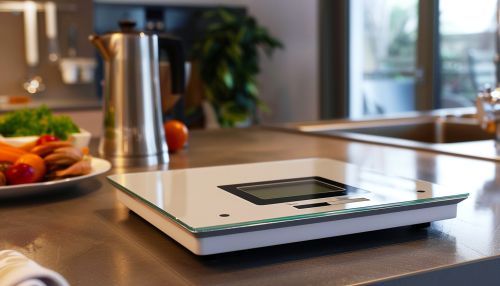Digital Scale
Introduction
A **digital scale** is an electronic device used to measure the weight or mass of an object. Unlike traditional mechanical scales, digital scales utilize electronic components and sensors to provide precise and accurate readings. These devices are widely used in various fields, including scientific research, industrial applications, healthcare, and everyday household use.
History
The development of digital scales can be traced back to the mid-20th century, with the advent of electronic technology. Early digital scales were bulky and expensive, primarily used in industrial and laboratory settings. Over time, advancements in microelectronics and sensor technology have made digital scales more compact, affordable, and accessible to the general public.
Components and Working Principle
Digital scales consist of several key components that work together to measure weight accurately:
Load Cell
The load cell is the heart of a digital scale. It is a transducer that converts the force exerted by the weight of an object into an electrical signal. Load cells are typically made of materials like aluminum or steel and contain strain gauges that deform under load, altering their electrical resistance.
Analog-to-Digital Converter (ADC)
The ADC is responsible for converting the analog signal from the load cell into a digital signal that can be processed by the scale's microcontroller. High-resolution ADCs are essential for achieving precise measurements.
Microcontroller
The microcontroller processes the digital signal from the ADC and performs necessary calculations to determine the weight. It also controls the display and other functions of the scale.
Display
The display shows the weight measurement to the user. Modern digital scales use LCD or LED displays for clear and easy-to-read results.
Power Supply
Digital scales require a power source, which can be batteries or an external power adapter. Some advanced models feature rechargeable batteries and energy-saving modes.


Types of Digital Scales
Digital scales come in various types, each designed for specific applications:
Analytical Balances
Analytical balances are highly precise digital scales used in laboratories for measuring small masses with high accuracy. They are equipped with draft shields to prevent air currents from affecting the measurement.
Precision Balances
Precision balances offer a good balance between accuracy and capacity. They are commonly used in industrial and laboratory settings for weighing larger samples.
Bathroom Scales
Bathroom scales are designed for personal use to measure body weight. They often include additional features such as body fat analysis and Bluetooth connectivity.
Kitchen Scales
Kitchen scales are used for measuring ingredients in cooking and baking. They are typically compact and have a tare function to subtract the weight of containers.
Industrial Scales
Industrial scales are robust and designed to handle heavy loads. They are used in manufacturing, shipping, and other industrial applications.
Calibration and Maintenance
Proper calibration and maintenance are crucial for ensuring the accuracy and longevity of digital scales:
Calibration
Calibration involves adjusting the scale to ensure its measurements are accurate. This process typically requires the use of certified calibration weights and should be performed regularly, especially in professional settings.
Maintenance
Regular maintenance includes cleaning the scale, checking for damage, and ensuring the load cell and other components are functioning correctly. It is also important to store the scale in a stable environment to prevent damage from temperature fluctuations and humidity.
Applications
Digital scales are used in a wide range of applications due to their precision and versatility:
Scientific Research
In scientific research, digital scales are essential for experiments that require precise measurements of chemicals, biological samples, and other materials.
Healthcare
In healthcare, digital scales are used to monitor patient weight, which is crucial for diagnosing and managing various medical conditions.
Industrial Applications
In industrial settings, digital scales are used for quality control, inventory management, and shipping. They help ensure products meet specified weight requirements and improve operational efficiency.
Retail
In retail, digital scales are used in grocery stores, markets, and other establishments to weigh products for sale. They often include features like price calculation and barcode printing.
Household Use
In households, digital scales are used for cooking, baking, and personal health monitoring. Their ease of use and accuracy make them a popular choice for everyday tasks.
Advantages and Disadvantages
Digital scales offer several advantages over traditional mechanical scales, but they also have some limitations:
Advantages
- **Accuracy:** Digital scales provide highly accurate measurements, often with resolutions as fine as 0.01 grams.
- **Ease of Use:** They are user-friendly, with clear displays and simple controls.
- **Additional Features:** Many digital scales come with features like tare function, unit conversion, and data storage.
- **Portability:** Modern digital scales are compact and lightweight, making them easy to transport and store.
Disadvantages
- **Cost:** High-precision digital scales can be expensive.
- **Power Dependency:** They require a power source, which can be a limitation in certain situations.
- **Sensitivity to Environment:** Digital scales can be affected by environmental factors like temperature and humidity, which may require frequent calibration.
Future Trends
The future of digital scales is likely to see further advancements in technology, including:
Integration with IoT
Integration with the Internet of Things (IoT) will enable digital scales to connect with other smart devices, allowing for automated data collection and analysis.
Enhanced Precision
Continued improvements in sensor technology and data processing will lead to even higher precision and accuracy in digital scales.
User-Friendly Interfaces
Future digital scales may feature more intuitive interfaces, including touchscreens and voice commands, to enhance user experience.
See Also
- Load Cell
- Analog-to-Digital Converter
- Microcontroller
- Analytical Balance
- Precision Balance
- Internet of Things
References
- No references available.
